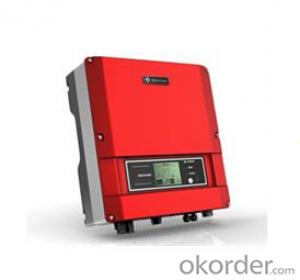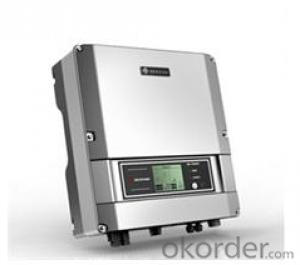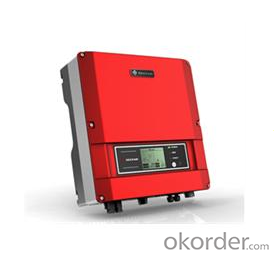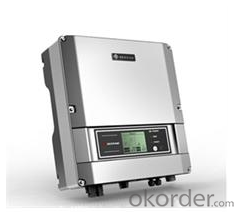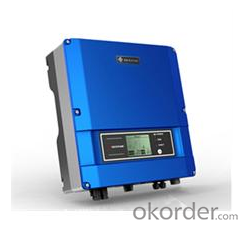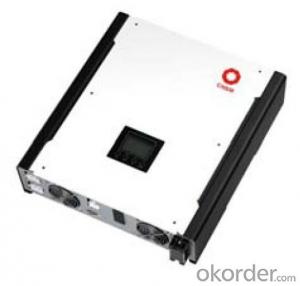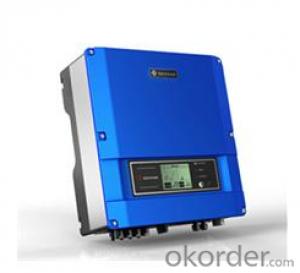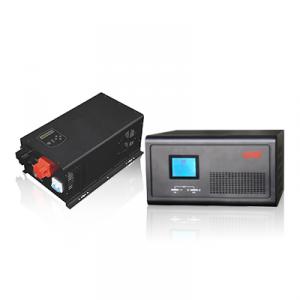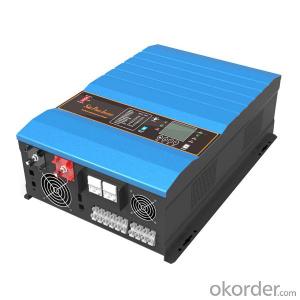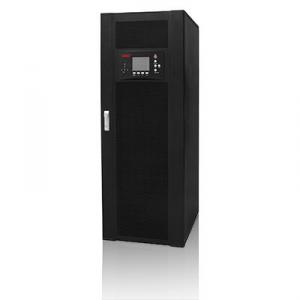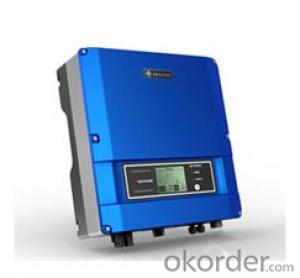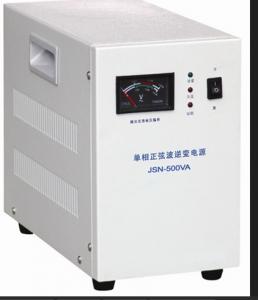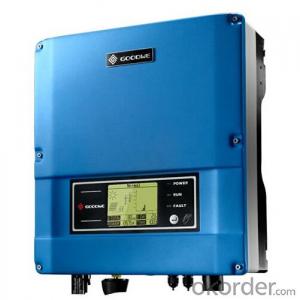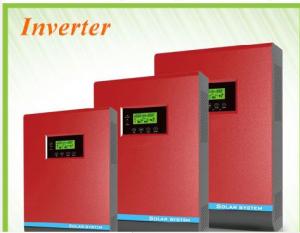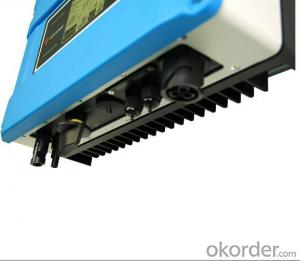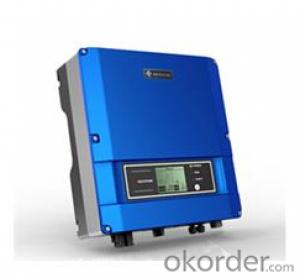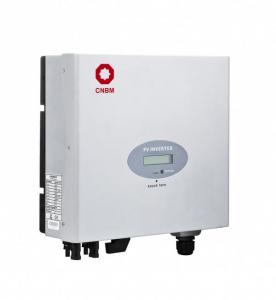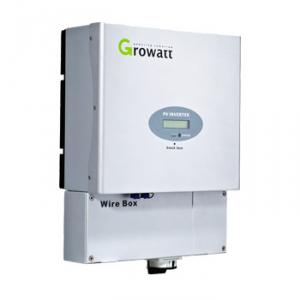Anker Solar Inverter GS4000-SS
- Loading Port:
- Shanghai
- Payment Terms:
- TT OR LC
- Min Order Qty:
- 10 unit
- Supply Capability:
- 100 unit/month
OKorder Service Pledge
OKorder Financial Service
You Might Also Like
GW4000-SS
GW4000-SS photovoltaic inverter is suitable for home rooftop photovoltaic system, designed under modern industrial concept. There are three colors for option with fashionable appearance. According to the test results of PHOTON laboratory, the medium irradiation efficiency is 96.9% and high irradiation efficiency is 97.1%. It has obtained Double A Certificates. It holds a safe lead among the same level of products in the world.
| Input Data | Max.PV-generator power[W] | 4600 |
| Max.DC voltage[V] | 580 | |
| MPPT voltage range[V] | 125~550 | |
| Turn on DC voltage[V] | 125 | |
Max.DC work current[A] | 20 | |
| Number of inputs/MPP trackers | 3/1 | |
| DC connection | MC IV Connector | |
| Self-energy consumption[W] | <5< td=""> | |
| AC Output Data | Nominal AC power[W] | 4000 |
| Max.AC power[W] | 4400 | |
| Max.output current[A] | 22 | |
| Nominal output voltage range | According to VDE 0126-1-1/AI, RD1663, ENEL, G83,G59,SAA | |
| AC grid frequency | According to VDE 0126-1-1/AI, RD1663, ENEL, G83,G59,SAA | |
| THDi | 〈1% | |
| Power factor | ~1 (Norminal power) | |
| AC connection | Single phase | |
| Efficiency | Max.efficiency | 97.8% |
| European efficiency | 97.4% | |
| MPPT adaptation efficiency | >99.5% | |
| Safty Equipment | Leakage current monitoring | Integrated |
| DC switch disconnector | Optional | |
| Islanding protection | AFD | |
| Grid monitoring | According to VDE 0126-1-1/AI,AS4777.1/2/3, RD1663, ENEL ,G83,G59-2 | |
| Normative Reference | EMC compliance | EN 61000-6-1,EN 61000-6-2, EN 61000-6-3,EN 61000-6-4 |
| Safety compliance | According to IEC 62109-1,AS3100 | |
| General Data | Dimensions(W*H*D) [mm] | 390*417*142 |
| Net weight [kg] | 18 | |
| Housing | For outdoor and indoor | |
| Mounting information | Wall mounting | |
| Operating temperature range | -20~60℃(up 45℃ derating) | |
| Relative humidity | 0 ~ 95% | |
| Site altitude[m] | 2000 | |
| IP proection class | IP65 | |
| Topology | Transformerless | |
| Cooling | Nature convection | |
| Noise level[dB] | 〈25 | |
| Display | 4" LCD | |
| Communication | USB2.0;RS485(Wireless/Bluetooth optional) | |
| Standard warranty[years] | 5/10(optional) |
- Q: Can a solar inverter be used in a solar-powered desalination system?
- Yes, a solar inverter can be used in a solar-powered desalination system. A solar inverter is responsible for converting the DC (direct current) output from solar panels into AC (alternating current) electricity that can be used to power various devices. In a solar-powered desalination system, the solar inverter would play a crucial role in converting the DC power generated by the solar panels into the AC power necessary to operate the desalination equipment, thereby enabling the system to function efficiently.
- Q: What is the role of a maximum power point tracker in a solar inverter?
- The role of a maximum power point tracker (MPPT) in a solar inverter is to constantly monitor and adjust the output voltage and current from the solar panels to ensure they are operating at their maximum power point. By tracking and maintaining this optimal operating point, the MPPT increases the overall energy efficiency and power output of the solar system. This is particularly important as solar panel performance can be affected by various factors such as shading, temperature, and varying sunlight intensity.
- Q: Can a solar inverter be used with a solar-powered remote monitoring system?
- Yes, a solar inverter can be used with a solar-powered remote monitoring system. The solar inverter is responsible for converting the DC (direct current) electricity generated by the solar panels into AC (alternating current) electricity that can be used to power various devices, including the remote monitoring system. This allows the system to operate efficiently and effectively, ensuring that the solar-powered remote monitoring system functions properly and provides real-time data monitoring.
- Q: How do you connect a solar inverter to the electrical grid?
- To connect a solar inverter to the electrical grid, you typically follow a few steps. First, ensure that your solar panels are properly installed and generating electricity. Then, connect the DC output of the solar panels to the DC input of the inverter. Next, connect the AC output of the inverter to your home's electrical distribution panel or directly to the electrical grid through a utility meter. Finally, consult with a qualified electrician to ensure that the installation meets all relevant safety and electrical codes.
- Q: Can a solar inverter be used for three-phase power systems?
- Yes, a solar inverter can be used for three-phase power systems. Three-phase solar inverters are specifically designed to convert the DC power generated by solar panels into AC power for three-phase electrical systems. These inverters are capable of handling higher power loads and are commonly used in commercial and industrial settings where three-phase power is required.
- Q: Can a solar inverter be used in systems with different module tilts?
- Yes, a solar inverter can be used in systems with different module tilts. Solar inverters are designed to convert the DC power generated by solar modules into AC power that can be used in electrical systems. They are typically compatible with a wide range of module tilts and orientations. However, it is important to ensure that the inverter is properly configured to match the specific tilt angles of the solar modules for optimal performance and maximum energy generation.
- Q: Can a solar inverter be repaired or replaced if it malfunctions?
- Yes, a solar inverter can be repaired or replaced if it malfunctions. In many cases, minor issues can be resolved through repairs, such as replacing faulty components or fixing wiring problems. However, if the malfunction is severe or the inverter is beyond repair, it may need to be replaced with a new one.
- Q: Can a solar inverter be installed indoors?
- Yes, a solar inverter can be installed indoors.
- Q: Can a solar inverter be used with a solar-powered data center?
- Yes, a solar inverter can be used with a solar-powered data center. A solar inverter is an essential component that converts the direct current (DC) generated by solar panels into usable alternating current (AC) electricity for powering electrical devices and systems, including data centers. By using a solar inverter, a solar-powered data center can efficiently utilize the renewable energy generated by solar panels to meet its power requirements.
- Q: Are there any safety considerations when installing a solar inverter?
- Yes, there are several safety considerations when installing a solar inverter. First, it is important to ensure that the installation is carried out by a qualified professional who is trained in handling electrical systems. This helps minimize the risk of electric shock or fire hazards. Additionally, proper grounding and insulation must be implemented to prevent electrical faults. It is also crucial to follow the manufacturer's guidelines and local electrical codes to ensure the safe and efficient operation of the inverter.
Send your message to us
Anker Solar Inverter GS4000-SS
- Loading Port:
- Shanghai
- Payment Terms:
- TT OR LC
- Min Order Qty:
- 10 unit
- Supply Capability:
- 100 unit/month
OKorder Service Pledge
OKorder Financial Service
Similar products
Hot products
Hot Searches
Related keywords
